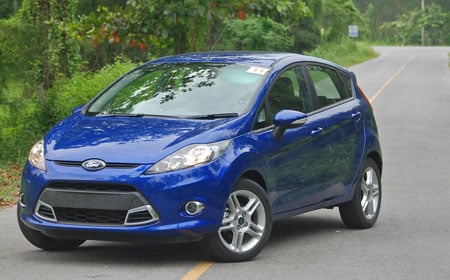
By now, many urban dwelling Malaysians and readers of this blog would have heard of or have seen the new Ford Fiesta. Ford distributor Sime Darby Auto ConneXion (SDAC) started drumming up awareness very early for this upcoming model, and as of today have received around 500 bookings, which is a decent sum.
The Fiesta should have its official launch in October but we have driven it in Thailand, where it rolls off the AutoAlliance plant alongside the Mazda2. We reckon that the Fiesta is a very impressive package, so much so that the observations you read after the jump are from a potential buyer – I really can see myself happy with one of these!
Continue reading the report after the jump.
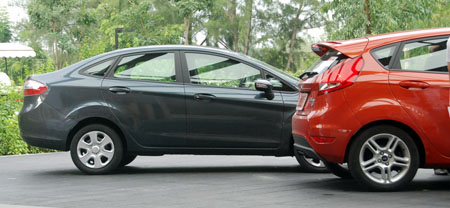
As previously announced, the B-segment Fiesta will come in both five-door hatchback and four-door sedan format, like platform buddy Mazda2. We will get an entry 1.4-litre manual hatchback, mid spec 1.6-litre sedan and the range topping 1.6-litre hatchback with all the bells and whistles. The engines of the latter two are Ford’s new Ti-VCT unit (Twin Independent Variable Camshaft Timing) with 118 bhp (120 PS) and 152 Nm paired to a six-speed Powershift dual clutch gearbox. When it’s launched, the Fiesta will be the most affordable car in Malaysia with a twin-clutch transmission.
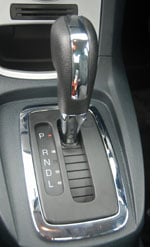 As a more enthusiastic driver, I asked Stefan Muenzinger, Head of Vehicle Integration for Ford Asia Pacific, why doesn’t the Fiesta come with manual override for its Powershift box, and the simple answer given was that “it’s a gimmick”. Apparently, Ford conducted studies on this and came up with the conclusion that owners don’t really use manual mode after playing with it for awhile, initially. Potential owners, what say you?
As a more enthusiastic driver, I asked Stefan Muenzinger, Head of Vehicle Integration for Ford Asia Pacific, why doesn’t the Fiesta come with manual override for its Powershift box, and the simple answer given was that “it’s a gimmick”. Apparently, Ford conducted studies on this and came up with the conclusion that owners don’t really use manual mode after playing with it for awhile, initially. Potential owners, what say you?
As for me, I reckon that a twin-clutch box is so much more than just an automatic replacement. If done right, it can be satisfying to row through the gears manually, like how one does in a DSG equipped VW; and when driving harder, it’s good to have veto power in your hands.
It’s OK if an affordable car doesn’t come with steering shift paddles, but the lack of Tiptronic style manual mode means those who enjoy a bit more involvement now and then are robbed of the pleasure. Here, it’s twin clutch for the efficiency without the fun. Should have been both, in my humble opinion.
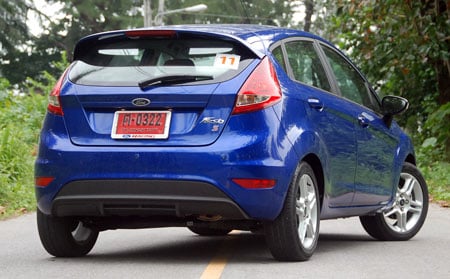
Now that I’ve got that off my chest, this Powershift unit isn’t the same box as the one in the Focus TDCi, but a smaller and lighter (by 13 kg) dry clutch unit for less torque demanding applications (below 250 Nm). This Getrag made unit (Ford is the only user at the moment) is the equivalent of VW’s 7-speed DSG, but like its Powershift siblings (Volvo uses them too) it’s not as slick as DSG in decision making and shifts are not as lightning quick. Still a very good option over a torque converter auto though, especially when the Fiesta 1.6’s fuel economy is rated at 16.4 km/l (6.1L/100 km) combined.
There’s a “sport” button to hold revs (works like OD off) as well as Hill Launch Assist, which holds the car for up to three seconds on a slope once you take your foot off the gas. Neutral Coast Down disengages the clutches when the car rolls to a stop, boosting fuel efficiency. The sealed transmission requires no maintenance, according to Ford.
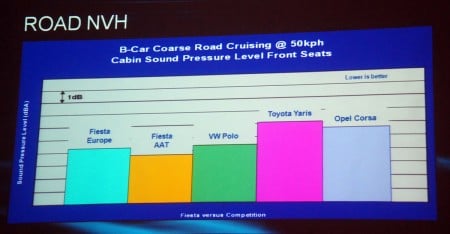
Click to enlarge slide. The VW Polo here is the Mk4 version
By the way, compared to Europe, US and China, Thailand is the last to start Fiesta production, and it’s a good thing in this case. Being the last in line, our Asia Pacific spec car incorporates many improvements that Ford “learned along the way” from introduction elsewhere. This effectively means that at present, we can buy a better Fiesta than Europeans and Americans, who will eventually get the enhancements.
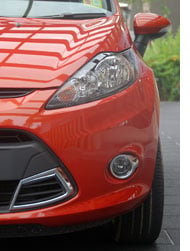 For now, things like a stiffer suspension bush attachment bracket and better sealing are unique to the Thai made car, which will replace the European sourced Fiesta in countries like Australia and Singapore. Noise, vibration and harshness (NVH) is one area that’s been improved over the European car. The front styling is also slightly different from region to region – our Fiesta gets extra chrome elements next to the foglamps.
For now, things like a stiffer suspension bush attachment bracket and better sealing are unique to the Thai made car, which will replace the European sourced Fiesta in countries like Australia and Singapore. Noise, vibration and harshness (NVH) is one area that’s been improved over the European car. The front styling is also slightly different from region to region – our Fiesta gets extra chrome elements next to the foglamps.
The 1.6-litre Ti-VCT unit has decent pick up and acceleration, and power is well spread throughout the rev range, evident as the tacho needle sweeps into the second half. Doesn’t sound too strained at high revs too, and certainly much less buzzy and noisy than in the 1.5-litre Mazda2. The Ford does 110 km/h at a relaxed 2,500 rpm, and cruisng at this speed is very serene. Wind and tyre noise are expertly kept out – only at about 150 km/h did we hear some wind rustle, and that was because we were actively looking out for it.
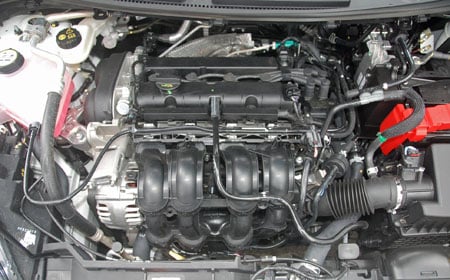
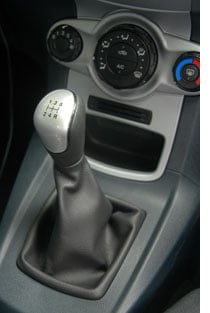 My second stint was in a 1.4 manual, which was surprisingly impressive. The Duratec unit was free revving and felt as sweet to extend (if not better) than the 1.6. I brought it pass 6,500 rpm without feeling like torture and with the stick shift, it didn’t feel much less perky than the 1.6 – so much so that I had to confirm with the engineers that it was indeed the 95 bhp/128 Nm 1.4 I was driving. Before you laugh, open the bonnets and you’ll find two identical looking engines save for a discreet VVT module – no logos or badging. By the way, the manual’s shift action is precise and the clutch is light and easy to use.
My second stint was in a 1.4 manual, which was surprisingly impressive. The Duratec unit was free revving and felt as sweet to extend (if not better) than the 1.6. I brought it pass 6,500 rpm without feeling like torture and with the stick shift, it didn’t feel much less perky than the 1.6 – so much so that I had to confirm with the engineers that it was indeed the 95 bhp/128 Nm 1.4 I was driving. Before you laugh, open the bonnets and you’ll find two identical looking engines save for a discreet VVT module – no logos or badging. By the way, the manual’s shift action is precise and the clutch is light and easy to use.
The highlight of the dashboard is the centre stack that was inspired by among other things, mobile phones, and the 1.6 gets a full phone keypad on the wing closer to the driver. Everything is displayed on a shared screen on the dash top, which has a fixed menu on the left side, lighting up the mode it’s in. There are also “soft keys” to complete the mobile phone image. Sounds complicated, but anyone using a modern mobile phone should have no problems navigating through.
Unlike the European spec, our Fiesta doesn’t come with padded plastics on the dash and door caps, as one would find in the Focus. But the texture of the plastic used here feels good, and the knuckle rap test doesn’t reveal hollow sounds. It’s something that I personally don’t mind, although some bright trim on the door handles would provide a more upmarket impression.
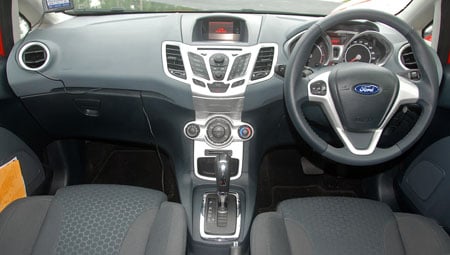
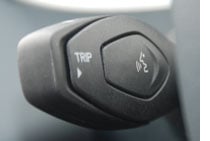 There’s a party trick called Voice Control where you press a button on the right stalk (the one that controls the signal lights) and speak out to command the stereo and climate control, like Mercedes’ Linguatronic. On a perfect day, a female voice would spell out your options and repeat your command. It’s akin to speaking with a automated phone operator when booking cinema tickets or banking.
There’s a party trick called Voice Control where you press a button on the right stalk (the one that controls the signal lights) and speak out to command the stereo and climate control, like Mercedes’ Linguatronic. On a perfect day, a female voice would spell out your options and repeat your command. It’s akin to speaking with a automated phone operator when booking cinema tickets or banking.
While cool, personally, I think that this is more of a gimmick than gearbox manual override. It’s much faster thumbing a few buttons for sure, although you do get to keep your eyes on the road ahead with VC. Also, I say “on a perfect day” because my few attempts at speaking to the system didn’t work. Maybe she just didn’t like me.
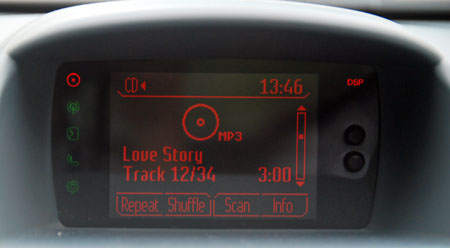
Predictably, the 1.4 doesn’t get Voice Control. It also misses out on the Bluetooth phone function although iPods and music players can be plugged in. The central screen is also a smaller unit with only two lines of text. I like the fact that although the centre stack has less functions on the 1.4, it doesn’t look so because there are no blank buttons; Ford cleverly replaced the “Phone” button with “Sound” for instance, and took out the soft keys, so you won’t be constantly reminded that you bought the entry level car.
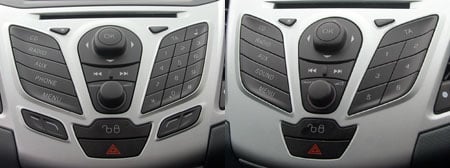
1.4 (right) lacks Bluetooth and Voice Control, but there are no blank buttons – a nice touch
Other differences are the lack of leather wrap on the steering and sport seats, although the latter is still very comfortable and is above par. Speaking about that, despite not having telescopic adjustment for the steering, the driving position is great for this writer thanks to a wide range of seat adjustments. Visibility is great except for a compromised off the shoulder rear view to accommodate the C-pillar design.
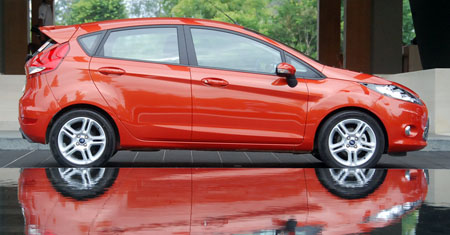
That leads us to the Fiesta’s cool design. Along with the Mazda2, this is the trendiest looking car in its class, but I’m more inclined to the sharper lines of the Ford. The antithesis of the VW Polo’s classy but super sober design, the Fiesta is adventurous and dynamic in outlook. The tapering roofline (accentuated here by the 1.6’s rear spoiler) and details such as the long, swept back headlights plus the prominent side character line that shoots upwards see to this. Following a hatchback on the move, me and my drive partner noticed the Fiesta’s wider and more squat stance compared to the Mazda2.
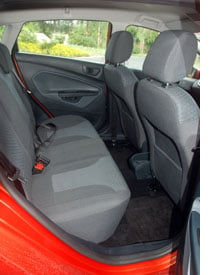 A look at the dimensions show that the Fiesta hatch is indeed wider than the Mazda, by 27 mm. At 3,950 mm, the Ford is also 55 mm longer than the Japanese car, although both share the same 2,490 mm wheelbase. Crucially for the Fiesta, rear headroom in the hatchback is much better than in the Mazda, which is constricting for this 175 cm writer. The hatchback’s boot will take in 281 litres, expandable to 961 litres with the rear seats folded. The sedan, which has the same width and height but is 341 mm longer at 4,291 mm, has a 430-litre boot. The lip is quite high, but the load area is deep and square.
A look at the dimensions show that the Fiesta hatch is indeed wider than the Mazda, by 27 mm. At 3,950 mm, the Ford is also 55 mm longer than the Japanese car, although both share the same 2,490 mm wheelbase. Crucially for the Fiesta, rear headroom in the hatchback is much better than in the Mazda, which is constricting for this 175 cm writer. The hatchback’s boot will take in 281 litres, expandable to 961 litres with the rear seats folded. The sedan, which has the same width and height but is 341 mm longer at 4,291 mm, has a 430-litre boot. The lip is quite high, but the load area is deep and square.
Ford says that the Fiesta represents the “truest and most expressive form of Kinetic Design” to date, and while they have a design language to follow, there’s a brief to avoid a “Russian doll effect” where the same look is duplicated across the range (Audi comes to mind). The supermini also survived the transformation from concept (Verve concept from the 2007 Frankfurt show) to production largely unchanged.
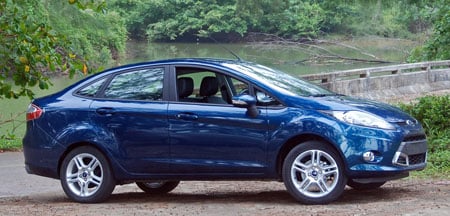
However, what’s good about the hatchback isn’t always fully translated to the sedan, which is often the case in the B-segment. The Mazda2 is a good case study. Its upswept window line looks great on the hatchback but leads to a seriously tall boot on the sedan. Couple that with a narrow body (the Mitsubishi Lancer looks fine, for instance) and you’ll get a gawky looking car with ungainly proportions. Mazda designers also didn’t put any elements on the boot lid to “break up” the high rump visual.
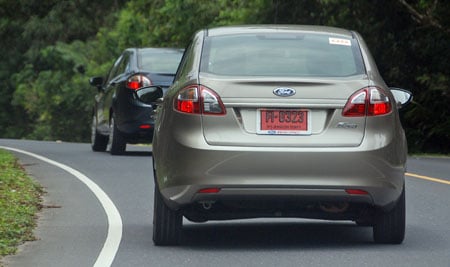
Ford did though, by locating the number plate and other elements on the boot lid. It doesn’t alter the awkward proportions, but they do help neutralise the effect a little. They also seeked to give the Fiesta sedan a “mini Mondeo” look with the taillight design and arrangement.
So it looks the part, but is the Fiesta as dynamic to drive as its looks suggest? Very much so. The ingredients are there: Ford is famous for great to drive cars, and this Thai made car is no dumbed down low cost model. We get customised spring and shock rates to suit the region’s roads, but roll characteristics are identical to the Euro spec car, so is torsional stiffness, which is higher than the Chinese market car.
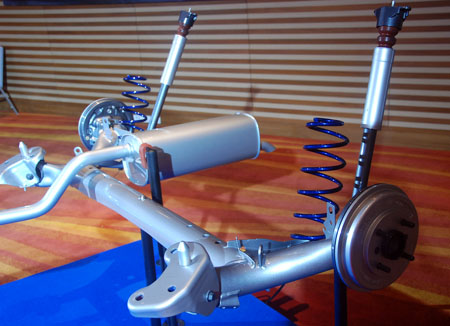
The tuning of our top range Fiesta’s “sport tuned suspension” (front struts, rear twist beam) is said to be in between Europe’s normal and Sport tunes (90% of European cars are on the standard set up); the latter is lowered and “totally not appropriate” for our conditions. Although the sedan gets unique spring/shock rates to accommodate the potentially heavier rear load, it’s tuned for the same feel as the hatchback. Bear in mind that suspension tuning is equally as important (if not more) than the hardware itself, which explains why some cars drive brilliantly with “just a rear torsion beam”.
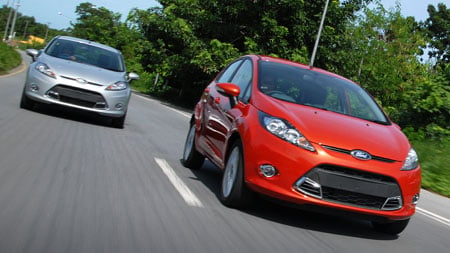
If you’ve driven a Focus or Mondeo, the Fiesta’s pleasing dynamics come as no surprise. While it flows nicely along an uneven B-road, we won’t call this “European feel” because not all Continental cars are made the same. The Fiesta’s suspension has been given “room to breathe” across undulations and ride comfort is good, both primary and low speed. The nice damping and good body control work well with the steering for a package that’s good to drive enthusiastically.
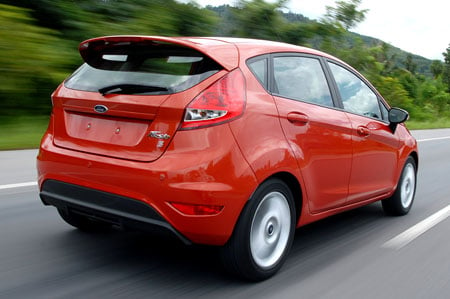
Following the efficiency trend, the steering ditches hydraulic assistance for an electric setup. The EPAS steering is light and isn’t exactly dripping with feel, but is very precise. There’s no slack or freeplay and the response is very linear as you wind on lock. I also like the feel of the brake pedal, which isn’t too sensitive or over assisted. Also, 1.6 models have the latest version of ESP as standard kit (Europe to get it soon).
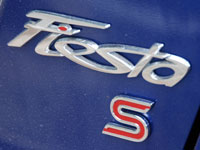 So the handling is good. The Mazda2 and Suzuki Swift has can be described as such too, but the Ford’s talents run deeper. It’s better on more roads and in more conditions. Perhaps it may lack the rather amazing front end grip of the Suzuki, losing a bit of the “go kart feel”, but go karts aren’t known for their comfort or ability on less than smooth surfaces!
So the handling is good. The Mazda2 and Suzuki Swift has can be described as such too, but the Ford’s talents run deeper. It’s better on more roads and in more conditions. Perhaps it may lack the rather amazing front end grip of the Suzuki, losing a bit of the “go kart feel”, but go karts aren’t known for their comfort or ability on less than smooth surfaces!
We’re looking forward to a longer local drive to reinforce/debunk these first impressions, but from the looks of it, Ford has a good all rounder in its hands, and this is a seductive package in my view. The price? RM73,888 for the 1.4 manual hatch, RM79,888 for the 1.6 sedan and RM84,888 for the 1.6 Sport. These attractive prices are on the road with insurance.
[zenphotopress number=999 album=1458]
Looking to sell your car? Sell it with Carro.

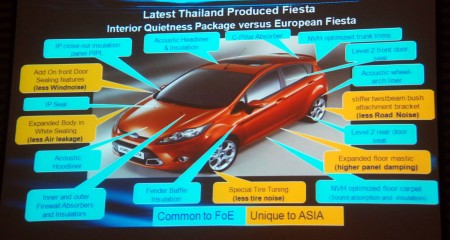














AI-generated Summary ✨
Comments praise the Ford Fiesta 1.4 and 1.6 Ti-VCT for its driving dynamics, sharp corners, and sporty appearance, especially the hatchback. Enthusiasts emphasize its handling, engine responsiveness, and features like the electronic throttle controller, although some criticize the absence of manual mode in the dual-clutch gearbox. The interior criticizes focus on plastic quality and limited features such as minimal airbags in certain variants. Several users mention the car's safety, fuel efficiency, and potential for customization. Concerns exist over resale value, spare parts cost, and aftersales service, with some comparing it unfavorably to Japanese rivals. Overall, the comments reflect a positive excitement for the car's design and performance, tempered by worries about durability, practicality, and brand perception. There’s a strong sense of anticipation mixed with skepticism about market acceptance.